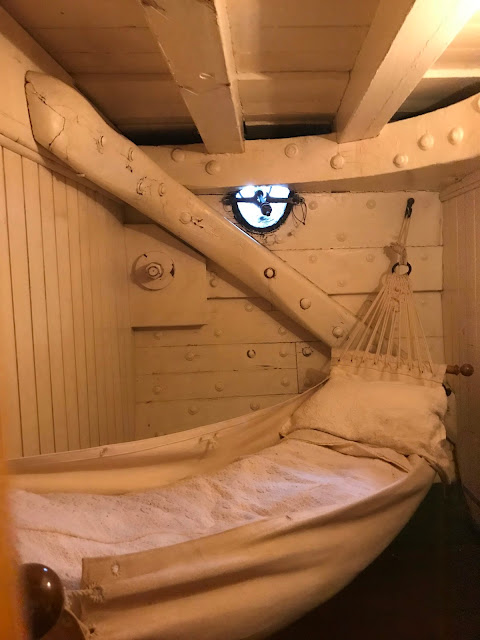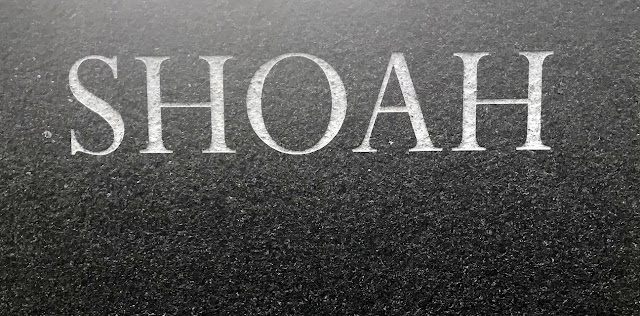From South Station, we took the MBTA to North Station and then walked to the Charleston Navy Yards to see the USS Constitution, informally known as Old Ironsides. The ship is considered a national park.
Before we got there, we saw this in the distance:
Nope, it did look like the Washington Monument that Jonah had seen a few days ago in Washington, D.C. But was actually the Bunker Hill Monument, which was built to commemorate the Battle of Bunker Hill in 1775, one of the first battles of the Revolutionary War. This monument was the model for the Washington Monument. It has 294 steps and people can climb up it. We didn't.
The USS Constitution was built in the Charleston Shipyard from 1794-1797 and became famous in the War of 1812. All ships built then were made of wood and powered by wind on sails. The wood used for the hull of this ship was harder than any wood used before the first six ships (including this one) was build for the new navy the US.
Once we got on the ship, a sailor explained the ammunition shot from the cannons. The one the sailor was touching could tear up sails. Navy sailors on the ship explain the history of the ship to the visitors that come from all over the world.
Did you notice that Jonah was wearing another hat? I got him a USS Constitution hat. 😀
There were usually a captain and four more officers on board the ship and up to 500 sailors who worked hard. The officers' quarters (rooms) were small but private.
And the officers' hammocks looked a lot more comfortable than the other sailors'.
The sailors' slept in one or two big rooms with the hammocks stacked with one or two on top of each other. The sailors got one hot meal a day around noon and then left overs for the other two meals. They usually got dried salted meat made into stew) and hardtack (a really hard, dried roll made edible when it was dunked into the stew). They either sat on the deck to eat or under the hammocks.
The main cannons were on the two levels below the open deck. They weighed 6,500 pounds, and each had a name. This one was called "Prudence." Others named used included "Victory or Death" and "Brother Jonathan." The cannons were on rollers and were front loaders, so about eight sailors were need to move the cannon back to load it with gun powder and roll it back to shoot it.
On the top deck there were smaller cannons that weighed 4,500 pounds. They were better for shooting from close range.
We took turns at the wheel.
The mast was VERY high. It took 8 men to raise each 1,500 lb sail.
The bow of the ship:
From the ship, we then went to the ship museum to learn more about history.
Through the middle of the 19th century, the commanders of the USS Constitution had significant jobs at sea.
Since 1971, the captains' role is to take care of the ship as it is at the shipyard, but it does go out to sea a bit each year.
 |
| Sailor Jonah |
 |
| Twisting twine to make it stronger |
 |
| A game teaching how to plan and execute a battle |
The navy had African American sailors in 1812, free men of color from the north, who mixed with the white sailors and got equal pay.
It wasn't until 1948 that the US Army integrated and official ended racial discrimination.Sailors often long hours every day. Their jobs included cleaning the deck with a holystone and cold sea salt water.
They also climbed up the masts, balancing on them to furl or unfurl the heavy canvas sails. Jonah could practice on a rope close to the ground!
Jonah found this board book, "B Is for Boston" in the museum gift shop and look what was mentioned for "O!"
We then walked back to North Station to take the T to Somerville and get cousin Eli from his after school program. Jonah followed the brick path of the Freedom Trail.
We passed the site of the old Boston Garden and the new TD Garden (the Boston Celtics home base).
The next morning we took the T from Davis Square, and went to North Station again, and walked to the Old North Church. Jonah really enjoyed learning the history of Boston as the Revolutionary War was about to begin and we were there for over an hour.
On the outside of the church, we saw this:
This is how the church began:
The members of the Episcopal church were well-to-do. A pew box cost about 25 British pounds a year to "own," which is almost a year's salary for a common laborer. So poorer people did not attend this church. The selling of these boxes ended in 1912. The balcony seating was less expensive, but still costly. There was one long row of such boxes on the left, one of the right, and a double row of them down the middle of the church. People brought their own furniture to put in the boxes. After 1912, pew seats were added.
Many of the "boxes" had signs called "This Old Pew," which added details about the church, the participants, and the approaching war. Below is the story of Mary Gibbs, one of few women to own a pew. If you click on the underlined blue link above, you can read more about the people who owned these pews.
Before 1783, people in Massachusetts had slaves, and they wanted them to go to church, so some families bought seats for their slaves upstairs.
The walls were not a bland white originally as they are now. The colors below have been found under layers of paint.
General Gage, the British military governor, thought these acts would enrage the colonists, so he decided to have soldiers get the arms and other munitions stored around the colonies. On the first try, they got two cannons from Cambridge and other items from Charleston, which very much alarmed the settlers.
The colonists had an "illegal" Congress, and they formed an alarm network, so when they British marched again to gather weapons, the colonists could notify each other to hide their weapons. Hancock and Sam Adams fled to Lexington because they were wanted by the British for leading the Congress. General Gage planned to send 700 troops to Concord to get the weapons. The colonists set up messengers to warn the colonists when the British started to march.
Around 10 p.m. on April 18, 1775, Paul Revere set his lantern plan in motion. He "called upon a friend, and desired him to make the signals." But that friend remains a mystery as Revere never named him. The friend locked himself inside the church, climbed the stairs, snuck behind the organ to a door leading to the tower, and climbed seven more stories to the top of the steeple. He then lit the lanterns and held them from the highest window facing north for just one minute.
Revere had kept a detailed diary of his experiences while there is no written record of Dawes' ride. That is another reason there is so little recorded information about others who participated.
Below is an example of how owners of the pew boxes might have furnished their place.
Below are some other things that Jonah "discovered."
The plaque is incorrect in that since 1912, no pew boxes are "owned" any more.
When Lafayette visited the church and saw this bust of George Washington, he said that it was a more realistic portrayal of Washington than all the others that he had seen.
Here are some more details about the building itself.
Boston used to be smaller than now as Back Bay was a real bay and Boston harbor was larger. Hills on islands off the Boston coast were cut down in the mid 1800s and later and used to fill in those areas. Here is a great map that a docent explained to us.
After a long and interesting visit at the church, we heading out behind the church.
First we saw a memorial to American soldiers. There were blank dog tags for the American soldiers who had died in Afghanistan.
While at the church, Jonah found this sign on the pew that Captain Jackson "owned."
We watched a man in clothing from the 18th century tell us about chocolate. He showed us spices that were put in drinking chocolate and we learned that sweet chocolate was not created until the 19th century.
And then we got tastes of this rich, yummy (and not sweet) warm chocolate drink! It was good and very strong.
Jonah stood by a statue of Paul Revere and still wondered why he got so much attention. I said to blame it on Longfellow!
Between the church and Paul Revere statue, there were markers on the wall to remember people from the North End who helped create our country.
Here is an example of one of them--I had never heard of him.
Since the North End has traditionally been the home of Italians, there are some good pizza places nearby. We stopped at one, Galleria Umberto, where Sicilian cheese pizza is sold For $1.85 a slice, cash only. I read online not to get there too late as they often run out of pizza! Jonah ate two pieces and said that the pizza was great. I had a spinach calzone, the only dairy free item on the menu.
We then headed over to the Holocaust memorial, passing people setting up for the Haymarket open air market for the next day. On the way we passed a park and on the wall were plaques about the immigrants to the area.
Then we saw the Holocaust memorial from a distance. The names of all of those who were killed are written on the glass towers.
Shoah is the Hebrew word for the Holocaust.
We then continued to walk on the Freedom Trail, heading toward the State House.
We passed the statue of Samuel Adams.
And continued on to the State House where we spent close to an hour also.
This blog is getting so long that I think that I will call this part 1 and start part 2 tomorrow!










































































No comments:
Post a Comment